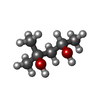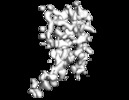+ データを開く
データを開く
- 基本情報
基本情報
| 登録情報 | データベース: EMDB / ID: EMD-7558 | |||||||||
|---|---|---|---|---|---|---|---|---|---|---|
| タイトル | MicroED structure of NaK ion channel reveals a process of Na+ partition into the selectivity filter | |||||||||
 マップデータ マップデータ | NaK ion channel | |||||||||
 試料 試料 |
| |||||||||
 キーワード キーワード | ion channel / NaK / TRANSPORT PROTEIN | |||||||||
| 機能・相同性 | Two pore domain potassium channel / Potassium channel domain / Ion channel / potassium channel activity / metal ion binding / identical protein binding / membrane / Transporter / Potassium channel protein 機能・相同性情報 機能・相同性情報 | |||||||||
| 生物種 |  | |||||||||
| 手法 | 電子線結晶学 / クライオ電子顕微鏡法 / 解像度: 2.5002 Å | |||||||||
 データ登録者 データ登録者 | Liu S / Gonen T | |||||||||
| 資金援助 |  米国, 1件 米国, 1件
| |||||||||
 引用 引用 |  ジャーナル: Commun Biol / 年: 2018 ジャーナル: Commun Biol / 年: 2018タイトル: MicroED structure of the NaK ion channel reveals a Na partition process into the selectivity filter. 著者: Shian Liu / Tamir Gonen /  要旨: Sodium (Na) is a ubiquitous and important inorganic salt mediating many critical biological processes such as neuronal excitation, signaling, and facilitation of various transporters. The hydration ...Sodium (Na) is a ubiquitous and important inorganic salt mediating many critical biological processes such as neuronal excitation, signaling, and facilitation of various transporters. The hydration states of Na are proposed to play critical roles in determining the conductance and the selectivity of Na channels, yet they are rarely captured by conventional structural biology means. Here we use the emerging cryo-electron microscopy (cryoEM) method micro-electron diffraction (MicroED) to study the structure of a prototypical tetrameric Na-conducting channel, NaK, to 2.5 Å resolution from nano-crystals. Two new conformations at the external site of NaK are identified, allowing us to visualize a partially hydrated Na ion at the entrance of the channel pore. A process of dilation coupled with Na movement is identified leading to valuable insights into the mechanism of ion conduction and gating. This study lays the ground work for future studies using MicroED in membrane protein biophysics. | |||||||||
| 履歴 |
|
- 構造の表示
構造の表示
| ムービー |
 ムービービューア ムービービューア |
|---|---|
| 構造ビューア | EMマップ:  SurfView SurfView Molmil Molmil Jmol/JSmol Jmol/JSmol |
| 添付画像 |
- ダウンロードとリンク
ダウンロードとリンク
-EMDBアーカイブ
| マップデータ |  emd_7558.map.gz emd_7558.map.gz | 10.3 MB |  EMDBマップデータ形式 EMDBマップデータ形式 | |
|---|---|---|---|---|
| ヘッダ (付随情報) |  emd-7558-v30.xml emd-7558-v30.xml emd-7558.xml emd-7558.xml | 10.7 KB 10.7 KB | 表示 表示 |  EMDBヘッダ EMDBヘッダ |
| 画像 |  emd_7558.png emd_7558.png | 62.9 KB | ||
| Filedesc metadata |  emd-7558.cif.gz emd-7558.cif.gz | 5.1 KB | ||
| Filedesc structureFactors |  emd_7558_sf.cif.gz emd_7558_sf.cif.gz | 509.9 KB | ||
| アーカイブディレクトリ |  http://ftp.pdbj.org/pub/emdb/structures/EMD-7558 http://ftp.pdbj.org/pub/emdb/structures/EMD-7558 ftp://ftp.pdbj.org/pub/emdb/structures/EMD-7558 ftp://ftp.pdbj.org/pub/emdb/structures/EMD-7558 | HTTPS FTP |
-検証レポート
| 文書・要旨 |  emd_7558_validation.pdf.gz emd_7558_validation.pdf.gz | 522 KB | 表示 |  EMDB検証レポート EMDB検証レポート |
|---|---|---|---|---|
| 文書・詳細版 |  emd_7558_full_validation.pdf.gz emd_7558_full_validation.pdf.gz | 521.6 KB | 表示 | |
| XML形式データ |  emd_7558_validation.xml.gz emd_7558_validation.xml.gz | 4.2 KB | 表示 | |
| CIF形式データ |  emd_7558_validation.cif.gz emd_7558_validation.cif.gz | 4.7 KB | 表示 | |
| アーカイブディレクトリ |  https://ftp.pdbj.org/pub/emdb/validation_reports/EMD-7558 https://ftp.pdbj.org/pub/emdb/validation_reports/EMD-7558 ftp://ftp.pdbj.org/pub/emdb/validation_reports/EMD-7558 ftp://ftp.pdbj.org/pub/emdb/validation_reports/EMD-7558 | HTTPS FTP |
-関連構造データ
| 関連構造データ |  6cpvMC M: このマップから作成された原子モデル C: 同じ文献を引用 ( |
|---|---|
| 類似構造データ | 類似検索 - 機能・相同性  F&H 検索 F&H 検索 |
- リンク
リンク
| EMDBのページ |  EMDB (EBI/PDBe) / EMDB (EBI/PDBe) /  EMDataResource EMDataResource |
|---|---|
| 「今月の分子」の関連する項目 |
- マップ
マップ
| ファイル |  ダウンロード / ファイル: emd_7558.map.gz / 形式: CCP4 / 大きさ: 11.4 MB / タイプ: IMAGE STORED AS FLOATING POINT NUMBER (4 BYTES) ダウンロード / ファイル: emd_7558.map.gz / 形式: CCP4 / 大きさ: 11.4 MB / タイプ: IMAGE STORED AS FLOATING POINT NUMBER (4 BYTES) | ||||||||||||||||||||||||||||||||||||||||||||||||||||||||||||||||||||
|---|---|---|---|---|---|---|---|---|---|---|---|---|---|---|---|---|---|---|---|---|---|---|---|---|---|---|---|---|---|---|---|---|---|---|---|---|---|---|---|---|---|---|---|---|---|---|---|---|---|---|---|---|---|---|---|---|---|---|---|---|---|---|---|---|---|---|---|---|---|
| 注釈 | NaK ion channel | ||||||||||||||||||||||||||||||||||||||||||||||||||||||||||||||||||||
| 投影像・断面図 | 画像のコントロール
画像は Spider により作成 これらの図は立方格子座標系で作成されたものです | ||||||||||||||||||||||||||||||||||||||||||||||||||||||||||||||||||||
| ボクセルのサイズ | X: 0.51569 Å / Y: 0.51569 Å / Z: 0.53155 Å | ||||||||||||||||||||||||||||||||||||||||||||||||||||||||||||||||||||
| 密度 |
| ||||||||||||||||||||||||||||||||||||||||||||||||||||||||||||||||||||
| 対称性 | 空間群: 79 | ||||||||||||||||||||||||||||||||||||||||||||||||||||||||||||||||||||
| 詳細 | EMDB XML:
CCP4マップ ヘッダ情報:
| ||||||||||||||||||||||||||||||||||||||||||||||||||||||||||||||||||||
-添付データ
- 試料の構成要素
試料の構成要素
-全体 : NaK
| 全体 | 名称: NaK |
|---|---|
| 要素 |
|
-超分子 #1: NaK
| 超分子 | 名称: NaK / タイプ: complex / ID: 1 / 親要素: 0 / 含まれる分子: #1-#2 |
|---|---|
| 由来(天然) | 生物種:  |
-分子 #1: Potassium channel protein
| 分子 | 名称: Potassium channel protein / タイプ: protein_or_peptide / ID: 1 / コピー数: 2 / 光学異性体: LEVO |
|---|---|
| 由来(天然) | 生物種:  |
| 分子量 | 理論値: 10.706538 KDa |
| 組換発現 | 生物種:  |
| 配列 | 文字列: WKDKEFQVLF VLTILTLISG TIFYSTVEGL RPIDALYFSV VTLTTVGDGN FSPQTDFGKI FTILYIFIGI GLVFGFIHKL AVNVQLPSI LSNLVPR UniProtKB: Transporter |
-分子 #2: SODIUM ION
| 分子 | 名称: SODIUM ION / タイプ: ligand / ID: 2 / コピー数: 12 |
|---|---|
| 分子量 | 理論値: 22.99 Da |
-分子 #3: (4S)-2-METHYL-2,4-PENTANEDIOL
| 分子 | 名称: (4S)-2-METHYL-2,4-PENTANEDIOL / タイプ: ligand / ID: 3 / コピー数: 1 / 式: MPD |
|---|---|
| 分子量 | 理論値: 118.174 Da |
| Chemical component information |  ChemComp-MPD: |
-分子 #4: water
| 分子 | 名称: water / タイプ: ligand / ID: 4 / コピー数: 4 / 式: HOH |
|---|---|
| 分子量 | 理論値: 18.015 Da |
| Chemical component information |  ChemComp-HOH: |
-実験情報
-構造解析
| 手法 | クライオ電子顕微鏡法 |
|---|---|
 解析 解析 | 電子線結晶学 |
| 試料の集合状態 | 3D array |
- 試料調製
試料調製
| 緩衝液 | pH: 7 |
|---|---|
| 凍結 | 凍結剤: ETHANE |
- 電子顕微鏡法
電子顕微鏡法
| 顕微鏡 | FEI TECNAI F20 |
|---|---|
| 撮影 | フィルム・検出器のモデル: TVIPS TEMCAM-F416 (4k x 4k) 平均電子線量: 0.1 e/Å2 |
| 電子線 | 加速電圧: 200 kV / 電子線源:  FIELD EMISSION GUN FIELD EMISSION GUN |
| 電子光学系 | 照射モード: FLOOD BEAM / 撮影モード: DIFFRACTION / カメラ長: 1750 mm |
| 実験機器 |  モデル: Tecnai F20 / 画像提供: FEI Company |
- 画像解析
画像解析
| 最終 再構成 | 解像度のタイプ: BY AUTHOR / 解像度: 2.5002 Å / 解像度の算出法: DIFFRACTION PATTERN/LAYERLINES |
|---|---|
| Crystallography statistics | Number intensities measured: 27479 / Number structure factors: 5643 / Fourier space coverage: 81.7 / R sym: 0.206 / R merge: 0.206 / Overall phase error: 20.27 / Overall phase residual: 20.27 / Phase error rejection criteria: 0 / High resolution: 2.5002 Å / 殻 - Shell ID: 1 / 殻 - High resolution: 2.5002 Å / 殻 - Low resolution: 3.1486 Å / 殻 - Number structure factors: 2685 / 殻 - Phase residual: 22.68 / 殻 - Fourier space coverage: 0.76 / 殻 - Multiplicity: 4.1 |
-原子モデル構築 1
| 精密化 | 温度因子: 41 |
|---|---|
| 得られたモデル |  PDB-6cpv: |
 ムービー
ムービー コントローラー
コントローラー






 Z (Sec.)
Z (Sec.) X (Row.)
X (Row.) Y (Col.)
Y (Col.)





















